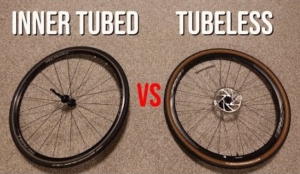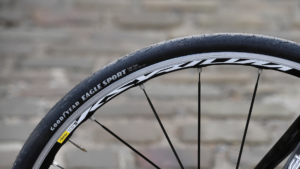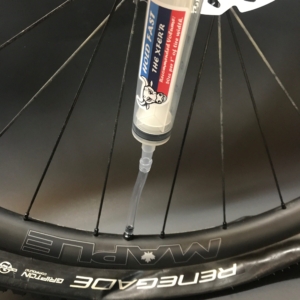Tech Talk: Tubes or Tubeless?
 A subject of conversation on our different club rides often touches on the matter of tires and tubes. If you are to buy a new bike today, chances are your bike comes ready to go with tubeless tires. Maybe you’re not convinced on them, so would you put inner tubes in your tires? Perhaps you have debated in your mind the pros and cons. For this edition of the Quick Releases, we consult our in-house advocates, John Burkhardt for the “tube camp” and Richard Higgins for the “tubeless.” Our experienced guests (who are friends) will explore the upside and the downside for each. Their opinions may resonate with your thoughts and may help you decide one way or another. For me personally I live in both worlds. ✎
A subject of conversation on our different club rides often touches on the matter of tires and tubes. If you are to buy a new bike today, chances are your bike comes ready to go with tubeless tires. Maybe you’re not convinced on them, so would you put inner tubes in your tires? Perhaps you have debated in your mind the pros and cons. For this edition of the Quick Releases, we consult our in-house advocates, John Burkhardt for the “tube camp” and Richard Higgins for the “tubeless.” Our experienced guests (who are friends) will explore the upside and the downside for each. Their opinions may resonate with your thoughts and may help you decide one way or another. For me personally I live in both worlds. ✎
 TUBES, John Burkhardt, Club Member: I have yet to make the jump to tubeless, for a number of reasons. The first is that I have used tubes for too many years to count, and in doing so have a substantial reservoir of experience for both installation and repair. That translates to running on auto pilot most of the time for all maintenance, especially fixing flats. I’ve never been unable to fix a flat, and with Park Tool boots, even the largest slice can be managed. The introduction of CO2, and now electric mini-pumps, turns it into a 5-10-minute job with none of the leaky colored sealant I have seen cover tires, frames, and riders when the punctures are large enough that tubes are required because plugs won’t handle the hole size. Another issue is that tubeless ready rims can be exceedingly difficult to mount and dismount tires on, due to the hooked beads on the rims for clincher tires. For me, as a solo or touring rider, that would be problematic in a remote area if I flatted. I once encountered a mountain biker with an unfixable tubeless flat that punctured next to a tire nob, making plugging impossible, who didn’t have a tube large enough for their very large diameter tire. His only choice at that point was walking or Uber. In summary, the issues with tubeless outweigh the benefits, so I don’t see using them until the technology becomes more user friendly.
TUBES, John Burkhardt, Club Member: I have yet to make the jump to tubeless, for a number of reasons. The first is that I have used tubes for too many years to count, and in doing so have a substantial reservoir of experience for both installation and repair. That translates to running on auto pilot most of the time for all maintenance, especially fixing flats. I’ve never been unable to fix a flat, and with Park Tool boots, even the largest slice can be managed. The introduction of CO2, and now electric mini-pumps, turns it into a 5-10-minute job with none of the leaky colored sealant I have seen cover tires, frames, and riders when the punctures are large enough that tubes are required because plugs won’t handle the hole size. Another issue is that tubeless ready rims can be exceedingly difficult to mount and dismount tires on, due to the hooked beads on the rims for clincher tires. For me, as a solo or touring rider, that would be problematic in a remote area if I flatted. I once encountered a mountain biker with an unfixable tubeless flat that punctured next to a tire nob, making plugging impossible, who didn’t have a tube large enough for their very large diameter tire. His only choice at that point was walking or Uber. In summary, the issues with tubeless outweigh the benefits, so I don’t see using them until the technology becomes more user friendly.
 TUBELESS, Richard Higgins, Club Member: There are many benefits to going tubeless. First, no pinch flats. If you’re a heavier rider, “snake bite” pinches of the inner tube causing flats are forever eliminated. There’s no inner tube to puncture. Second, you get fewer flats. The liquid sealant in the tubeless tire is designed to seal small holes. There will be instances when a pin hole seals itself, and the rider isn’t aware that a punch even occurred. Third, flats are easy to fix. In the case of a hole that the sealant can’t seal, there is a plug device (Dynaplug is my favorite) that fills a larger hole with a rubber “bacon” strip. It’s fast and easy. Plugging a hole on the front tire and riding away can be done without even getting off the bike. Ask club member Don Spencer. Fourth, your ride is smoother – lower air pressure. The latest test research demonstrates that lower air pressure and wider tires create the lowest rolling resistance. Pro cyclists ride 28 mm tires at air pressures around 50 PSI or less. Amateur riders are advised to ride 30-32 mm tires at the same or lower air pressure. Tubeless tires have a better feel, more supple. This one is my favorite benefit of tubeless tires. They just feel faster and smoother. I enjoy the ride. Fifth, all the UCI World Tour cycling teams ride tubeless (TL) tires or “tyres.”
TUBELESS, Richard Higgins, Club Member: There are many benefits to going tubeless. First, no pinch flats. If you’re a heavier rider, “snake bite” pinches of the inner tube causing flats are forever eliminated. There’s no inner tube to puncture. Second, you get fewer flats. The liquid sealant in the tubeless tire is designed to seal small holes. There will be instances when a pin hole seals itself, and the rider isn’t aware that a punch even occurred. Third, flats are easy to fix. In the case of a hole that the sealant can’t seal, there is a plug device (Dynaplug is my favorite) that fills a larger hole with a rubber “bacon” strip. It’s fast and easy. Plugging a hole on the front tire and riding away can be done without even getting off the bike. Ask club member Don Spencer. Fourth, your ride is smoother – lower air pressure. The latest test research demonstrates that lower air pressure and wider tires create the lowest rolling resistance. Pro cyclists ride 28 mm tires at air pressures around 50 PSI or less. Amateur riders are advised to ride 30-32 mm tires at the same or lower air pressure. Tubeless tires have a better feel, more supple. This one is my favorite benefit of tubeless tires. They just feel faster and smoother. I enjoy the ride. Fifth, all the UCI World Tour cycling teams ride tubeless (TL) tires or “tyres.”
I admit there are some limitations to tubeless tires. First, more maintenance – it’s best to refresh the sealant every three to six months. The refresh of sealant takes discipline. The sealant loses its hole-sealing efficacy over time, and you want it to seal the small holes. The process is simple: Let the air out of the tire. Remove the valve core with a $7 tool, squirt or pour the sealant into the tire via the valve stem. Reinstall the core and reinflate. This is particularly important after you’ve plugged a hole on the road. Second, there are more things to buy (i.e., tire maintenance supplies). The small bottles of sealant are 2.02 oz (60 ml) and sufficient for one tire. Large bottles at 16 oz (473 ml) are more economical. Reusing a small bottle to measure and pour is a simple hack. A 60 ml plastic syringe with plastic tubing that fits over the valve is available for purchase. Properly sized rim tape is a key component of the tubeless system. When replacing worn-out tires, inspect the rim tape for “fold-overs” and replace where air might leak out through the wheels at spoke nipple holes. Third, liquid sealant can be messy when changing out tires. Setting up your tires is not messy. Changing the worn-out tire on an existing wheel is best done outside. I dump out the old sealant and start fresh. This is also a suitable time to inspect rim tape. Fourth, other riders telling you that you’ve sprung a leak (leaking white stuff means you’re getting a flat). Still, tubeless tires are worth it!
Joel Loh, Club Member
